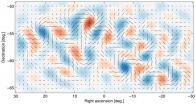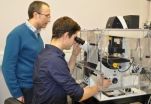(Press-News.org) This news release is available in German.
The path to developing new drugs is a long one. If a target is identified for a new active agent – for instance a particular protein that plays a key role in a disease – an active molecule that binds to the target must then be developed. Pharmaceutical companies trawl through their collections of chemicals for substances that act on the target protein in the desired fashion. However, these compounds are often just the starting point for a long process of adjustment and testing. Chemists use computer simulations to design new molecules to yield innovative compounds with the desired properties; however, undesirable effects often come to light only after the active agent has been synthesised and tested, and in the worst-case scenario only during the clinical trials.
To date, the prediction of side-effects using a computer has been limited. "Our aim is to detect problems as early as possible and synthesise only the most promising active agents," explains Gisbert Schneider, Professor of Computer-Assisted Drug Design at the Institute of Pharmaceutical Sciences, ETH Zurich. Many potential candidates that prove to have undesirable effects can thus be eliminated quickly.
Effective predictive module
Schneider's research team has developed a simulation module that can predict possible target activities of drug-like molecules more quickly and precisely than previous programmes. The algorithm checks the interaction of a molecule with up to 640 human proteins in just a few minutes. "This is currently the most effective predictive module in existence," says Schneider. A trial run with a cholesterol lowering agent, fenofibrate, which has a range of side-effects, showed all known interactions with unintended targets as well as some previously unknown. Some of the unexplained side-effects of the drug could be attributed to the latter.
However, the computer module is capable of even more: it combines molecular building blocks from a virtual building set to suggest new chemical entities. It also checks the interactions of these with the 640 human proteins and suggests the best module combination.
Following the scent mark
In order to allow the software to search for new composite agents, the research team uses an ant algorithm. Like an ant colony on the search for food, the algorithm screens through the molecular building blocks for components with the desired properties. Depending on the strength of the desirable and undesirable effects of the virtual products, the building blocks receive a 'grade'. In the ant world, this would equate to marking the trail to food with pheromones. In the next step, the components are recombined and the properties reassessed. In the process, a building block that received a high grade at the start can drop out of the short list, because it might has too many predicted adverse effects in combination with another building block. The 'scent mark' of the ant algorithm fades in this case, while the 'scent mark' for a better block combination is increased with every virtual combination step. In the end, the algorithm – like the ants – finds the quickest or best way to the goal by adaptive trial and error.
"Ant algorithms are used in robotics, for example for optimising manufacturing processes, but we have now transferred the trick to drug discovery," says Schneider. As not only one ant but an entire colony of ants looks for the path – in this case, numerous parallel and intercommunicating search processes – the simulation module designs new active agents within minutes and suggests the necessary chemical synthesis steps. "What previously took up to two weeks can now be done in a day, thanks to the new software." In a next step, Schneider's team wants to connect the computer module to a synthesis robot to fully automate the design and subsequent synthesis.
According to Schneider, in the future it may be possible to not only find the best active agent for a particular disease, but to develop medication for the individual patient. "If we could give the algorithm extra information, such as what the patient's protein world looks like, it could calculate the interactions to be expected for that particular patient." A suitable active substance could be selected and the patient treated with as few side-effects as possible.
INFORMATION:
Further reading:
Reker, R., Rodrigues, T., Schneider, P. and Schneider, G. Identifying the macromolecular targets of de novo designed chemical entities through self-organizing map consensus. Proc. Natl. Acad. Sci. USA, March 3, 2014, doi: 10.1073/pnas.1320001111
Reutlinger, M., Rodrigues, T., Schneider, P. and Schneider, G. Multi-objective molecular de novo design by adaptive fragment prioritization. Angew. Chem. Int. Ed., March 13, 2014, DOI: 10.1002/anie.201310864
Follow the ant trail for drug design
2014-03-18
ELSE PRESS RELEASES FROM THIS DATE:
Democrats, Republicans see each other as mindless -- unless they pose a threat
2014-03-18
We are less likely to humanize members of groups we don't belong to—except, under some circumstances, when it comes to members of the opposite political party. A study by researchers at New York University and Harvard Business School suggests that we are more prone to view members of the opposite political party as human if we view those individuals as threatening.
"It's hardly surprising that we dehumanize those who are not part of our groups," says Jay Van Bavel, an assistant professor in NYU's Department of Psychology and one of the study's co-authors. "However, what ...
Research on the protein gp41 could help towards designing future vaccinations against HIV
2014-03-18
This news release is available in Spanish. Researchers from the University of Granada have discovered, for the first time, an allosteric interaction (that is, a regulation mechanism whereby enzymes can be activated or de-activated) between this protein, which forms part of the sheath of the Human Immunodeficiency Virus (HIV) and the antibody 2F5 (FAB), a potent virus neutralizer. This important scientific breakthrough could help specialists to understand the mechanisms behind generating immune responses and help towards the design of future vaccines against the HIV ...
First direct evidence of cosmic inflation
2014-03-18
Almost 14 billion years ago, the universe we inhabit burst into existence in an extraordinary event that initiated the Big Bang. In the first fleeting fraction of a second, the universe expanded exponentially, stretching far beyond the view of our best telescopes. All this, of course, was just theory.
Researchers from the BICEP2 collaboration today announced the first direct evidence for this cosmic inflation. Their data also represent the first images of gravitational waves, or ripples in space-time. These waves have been described as the "first tremors of the Big Bang." ...
Immunologists present improved mass spectrometric method for proteomic analyses
2014-03-18
When it comes to analyzing cell components or body fluids or developing new medications, there is no way around mass spectrometry. Mass spectrometry is a highly sensitive method of measurement that has been used for many years for the analysis of chemical and biological materials. Scientists at the Institute of Immunology of the University Medical Center of Johannes Gutenberg University Mainz (JGU) have now significantly improved this analytical method that is widely employed within their field. They have also developed a software program for the integrated analysis of ...
UNH research: Positive memories of exercise spur future workouts
2014-03-18
DURHAM, N.H. – Getting motivated to exercise can be a challenge, but new research from the University of New Hampshire shows that simply remembering a positive memory about exercise may be just what it takes to get on the treadmill. This is the first study to explore how positive memories can influence future workouts.
"This study underscores the power of memory's directive influence in a new domain with practical applications: exercise behaviors. These results provide the first experimental evidence that autobiographical memory activation can be an effective tool in ...
Male, stressed, and poorly social
2014-03-18
Stress, this enemy that haunts us every day, could be undermining not only our health but also our relationships with other people, especially if we are men. In fact, stressed women apparently become more "prosocial". These are the main findings of a study carried out with the collaboration of Giorgia Silani, from the International School for Advanced Studies (SISSA) of Trieste. The study was coordinated by the Social Cognitive Neuroscience Unit of the University of Vienna and saw the participation of the University of Freiburg.
"There's a subtle boundary between the ...
What's so bad about feeling happy?
2014-03-18
Why is being happy, positive and satisfied with life the ultimate goal of so many people, while others steer clear of such feelings? It is often because of the lingering belief that happiness causes bad things to happen, says Mohsen Joshanloo and Dan Weijers of the Victoria University of Wellington in New Zealand. Their article, published in Springer's Journal of Happiness Studies, is the first to review the concept of aversion to happiness, and looks at why various cultures react differently to feelings of well-being and satisfaction.
"One of these cultural phenomena ...
Study fingers chickens, quail, in spread of H7N9 influenza virus
2014-03-18
Among the copious species of poultry in China, quail and chickens are the likely sources of infection of H7N9 influenza virus to humans, according to a paper published ahead of print in the Journal of Virology.
"Knowing the likely poultry species lets us target our interventions better to prevent human infections," says corresponding author David Suarez, of the United States Department of Agriculture.
The H7N9 avian influenza virus was first reported in humans in March 2013 in China. Since then over 375 human cases have been confirmed and over 100 have died. Only ...
New understanding of why chromosome errors are high in women's eggs
2014-03-18
A new study from the University of Southampton has provided scientists with a better understanding of why chromosome errors are high in women's eggs.
It is estimated that up to 60 per cent of eggs are affected by errors in how their chromosomes divide, making it the leading cause of infertility. Chromosome errors also lead to conditions such as Down Syndrome and early pregnancy loss.
By using state-of-the-art imaging techniques, the Southampton researchers examined the most important process present in all cells to prevent chromosome errors – the Spindle Assembly Checkpoint ...
Some truth to the 'potent pot myth'
2014-03-18
New research from The Netherlands shows that people who smoke high-potency cannabis end up getting higher doses of the active ingredient (THC). Although they reduce the amount they puff and inhale to compensate for the higher strength, they still take in more THC than smokers of lower potency cannabis.
For the past decade or more, the common sense idea that high strength cannabis leads to higher doses of THC and therefore poses a greater risk of unwanted effects such as dependency has been challenged and labelled the 'potent pot myth'. It has been argued that smokers ...

